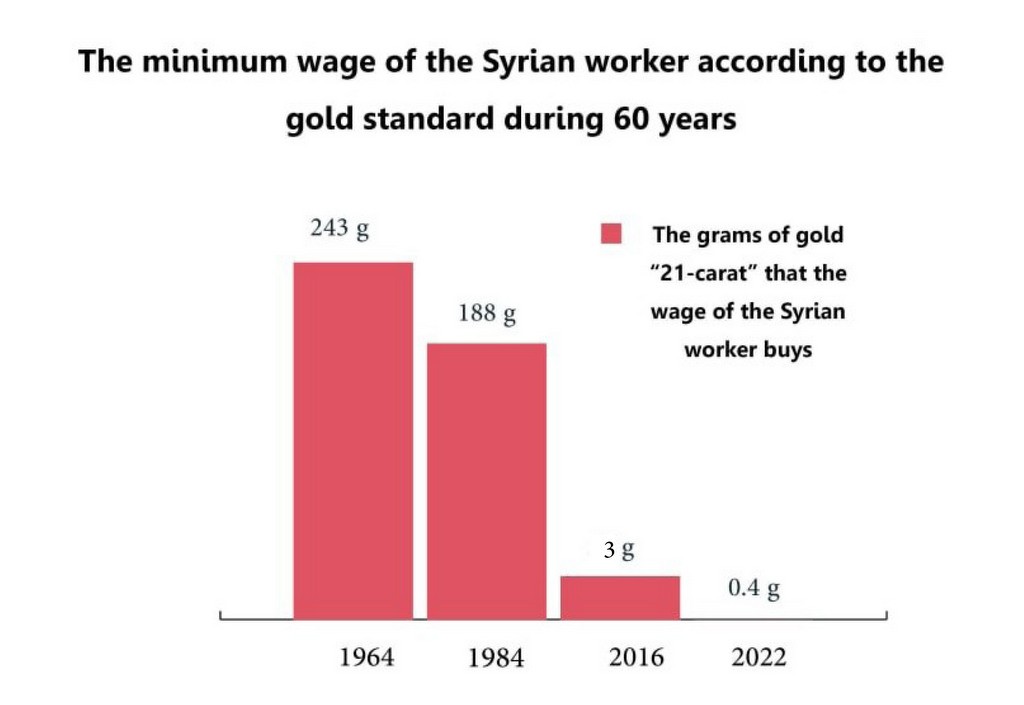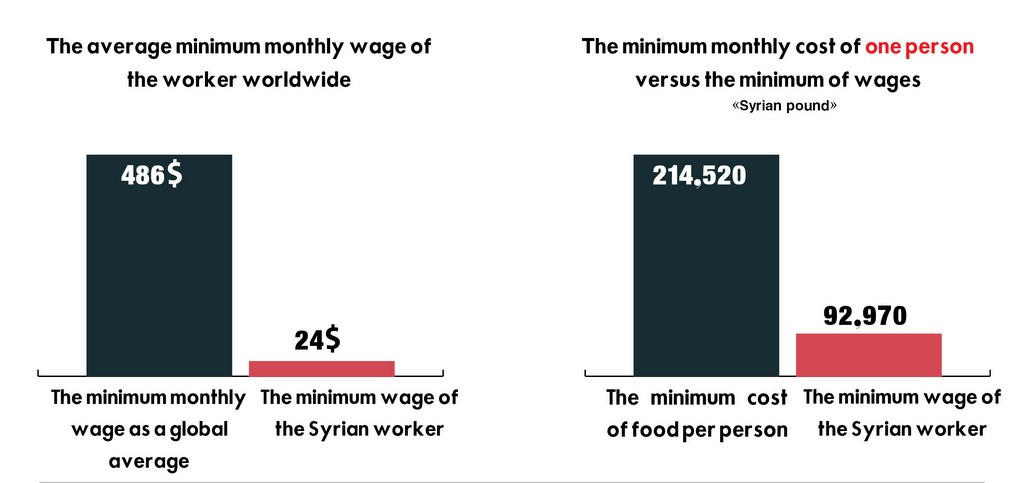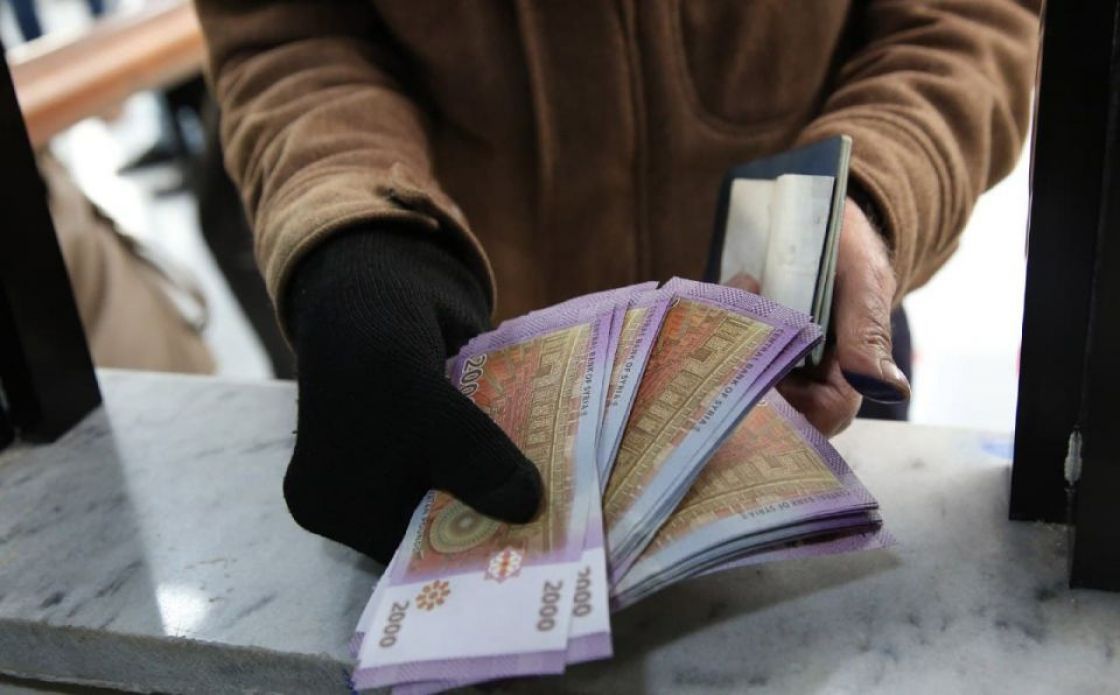- Articles
- Posted
A Long Time Ago: The State Apparatus Stopped Paying Real Wages
In the previous issue 1064, Kassioun newspaper published the index of Kassioun for the cost of living at the end of March 2022, in which it showed that the average cost of living for a Syrian family of 5 is 2.8 million Syrian pounds. It increased by about 833,405 Syrian pounds from the average cost that was recorded in the beginning of the current year. This has not been farfetched to millions of Syrians who are witnessing a daily and aggravated increase in the prices of basic food commodities necessary for their survival.
Faced with this unprecedented increase (41% during three months only), the question on how people are living under a system of extremely low wages remains relevant. The minimum of wages in Syria (92,970 Syrian pounds) represents a paradox, not only by local standards, but also globally.
From 243 to 0.4:
A System of Continuous Decline
While talking about the huge gap between wages and costs of living in Syria, some jump to the hasty conclusion that this damage has been there since ever in the country, and that this gap was always there in it. However, looking closely to the development of wages in Syria is enough to respond to this belief, which shows that the wage of the Syrian worker has not always been at the current catastrophic level.
If we adopted the gold standard as a tool to measure the development of real wages in Syria, we see that these wages have been going at a steady downward pace from the mid-1960s to this day. The minimum of wages in 1964 was worth 243 grams of 21-carat gold. After 20 years, in 1984, the minimum of wages fell to the value of 188 grams of gold, and continued to deteriorate until it reached 3 grams in 2016, but today, it is only 0.4 grams! If we rephrased this in another way, we will be able to see the real decline in wages: if the minimum of wages of the Syrian worker now buys the same amount of gold that it used to buy in 1964, then the minimum of wages today should be 52,132,005 Syrian pounds! If it was to buy the same amount of gold that it used to buy in 1984, then the minimum of wages today should be 40,332,580 Syrian pounds.
Not to go this far, if the minimum of wages in Syria was able to buy the same amount of gold it used to buy 6 years ago in 2016, the minimum of wages today should be 654,000 Syrian pounds instead of 92,970 Syrian pounds!

4.9% of the Global Average
The image of Syrian wages is no less bleak if we leave aside the gold standard and evaluate according to the dollar, on which the actual prices of commodities today are based, as it forms the basis of economic activity in the Syrian market, and more than 70% of locally produced food are associated with it.
In this way, the minimum wage of the Syrian worker today is no more than $24, which is not only an unprecedented figure at the local level, but a shocking figure even by international standards. According to the International Labour Organization, the average minimum wage globally is no less than $486 a month. That is, the minimum of wages in Syria is equivalent to only 4.9% of the average minimum wage globally.

What the Wage Buys
Even if we leave the standards of gold and the dollar aside, the market is enough to reveal the truth, as the prices of commodities generally, and the prices of food particularly, reveal the inhumane side of wages in Syria. The 92,970 Syrian pounds the Syrian worker receives are not enough to cover the costs of food for a family for 3 days (without calculating other costs of living, as we are talking here about the cost of necessary food only). The monthly cost of food of the Syrian worker by himself reaches 214,520 Syrian pounds, which means that the minimum of wages is enough to cover the cost of necessary food of the worker alone for 14 days only!

Is There a Wage?
This, of course, leads us to re-ask the question of how are people living under this wage system. The simple answer of this is that the State apparatus has stopped paying real wages for workers a long time ago. When the minimum of wages is not enough to cover the average cost of living completely, we can talk about an imbalance in wages, but when the difference between the minimum of wages and the average cost of living is astronomical to the point where it only covers 3.2% of these costs (as the situation is today), it is not possible to talk about the existence of wages in the first place, but about “something like wages” in a country where the vast majority of its population depends on external remittances and inhuman adaptation mechanisms.



